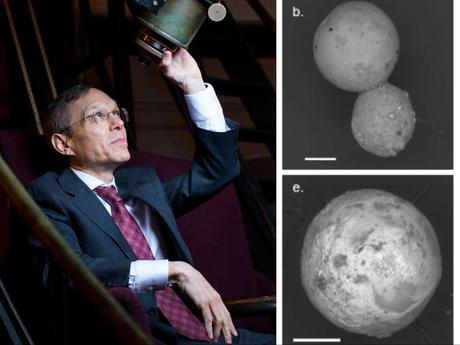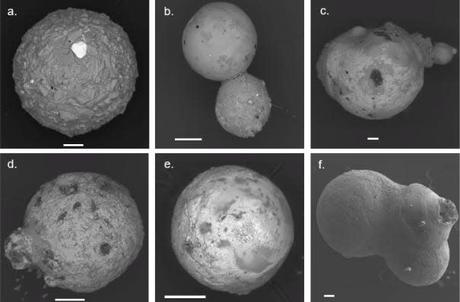
-
Harvard astronomer Avi Loeb searched the seafloor in the Pacific Ocean last year looking for meteor debris.
He said he has found metal spheres that "may reflect an alien technological origin."
A new study now suggests that Loeb may have been looking for the meteor debris in the wrong place.
Yet another study questions a Harvard professor's claims that metal balls may have been discovered beneath the ocean made by aliens.
Last year, Avi Loeb, director of a computational astrophysics center at Harvard, said metal balls found in the Pacific Ocean were left behind by a meteor that exploded near Earth in 2014.
He said their bizarre chemical composition "could reflect an extraterrestrial technological origin."
His claims were criticized by parts of the scientific community who believed in them Loeb made wild claims without sufficient evidence to support them.
Now researchers believe Loeb's costly expedition, searching for evidence of alien technology on the seabed, was more than 100 miles (160 kilometers) from its goal because it was misled by seismic data.
Research led by Johns Hopkins University (JHU) shows that a beep on the seismometer Loeb used to locate the crash site may have simply been caused by the vibrations of a passing truck.
If true, it means that exotic metal bullets found on the seabed may not be related to the alien rock, Ben Fernando, a postdoctoral researcher at JHU and lead author of the analysis, told Business Insider in an interview.
"It seems very likely that the spot on the seabed they were looking for was incorrect. Therefore, whatever they found on the seabed that they thought came from this media actually had nothing to do with it," he said .
Locating the crash site
In 2019, Loeb and his team searched databases for unusual meteors that moved quickly. Then they encountered a meteor fireball that arrived in Earth's atmosphere in 2014.
The story continues
The meteor, named IM1 by Loeb's team, was first spotted by Department of Defense (DoD) sensors. These said the meteor reached the atmosphere at a speed of 44 kilometers per second, a high speed indicating that the meteor came from outside the solar system.
This left Loeb wondering if the 2014 object was an alien probe. Loeb wanted to remove debris from the object to test his theory.
The Department of Defense proposed a location for the meteor impact site, which Loeb and his team used as a baseline to locate a 46-square-mile area where the meteor may have crashed.
Readings from a nearby seismometer were then used to further narrow their search area to a 10 square kilometer area of interest off the coast of Papua New Guinea.
Here the expedition looked for globules, characteristic metal spheres that are often left behind by meteors that crash into the atmosphere.
Loeb's team recovered 805 beads. A tenth of these contained unusual levels of three metal elements - beryllium, lanthanum, uranium - and atypical isotopes, according to their analysis. According to them, this could indicate an interstellar origin.
One hypothesis is that the meteor came from the crust of a planet outside the solar system. Loeb went one step further in the paper and suggested that it is possible that the bizarre composition means that the meteor consists of alien technology.


Another theory
The JHU-led study, which has not been peer-validated, suggested that Loeb and his colleagues had misread the seismic measurements from Papua New Guinea.
They said this could be explained by nearby city noises, rather than shock waves caused by a meteor crashing nearby.
"It's probably the signal of a truck driving past the seismometer," Fernando said.
Fernando added that the DoD's measurements are notoriously inaccurate when it comes to determining the speed and location of near-Earth objects.
To support its theory, the JHU-led team tracked down data from acoustic measuring equipment placed in the area. These car-sized microphones are typically used to detect illegal nuclear tests and are finely tuned to detect explosions in the atmosphere, Fernando said.
This analysis, they said, places the meteor's location about 120 miles (190 kilometers) from the area Loeb surveyed.
"Fundamentally, I think the big difference is that our team has people who study sound waves, people who are seismologists and people who study fireballs," says Fernando.
"And as far as I know, they don't have any of these three on their team, which doesn't mean they don't have the right to publish about this, but it may have caused them to misinterpret or misunderstand the data ." they were downloading," he said.
Loeb disagrees with the JHU analysis and states that the seismic measurements were only used to confirm data from other sources.
"What arrives on Earth from outside the solar system should be studied by scientists who are serious about paying attention to new data, not ridiculed by poorly motivated debunkers," he said in a Medium post on Sunday.
The findings will be presented Tuesday at the Lunar and Planetary Science Conference in Houston.
No stranger to controversy
This isn't Loeb's first attempt at controversy. The professor first made headlines when he said it was reasonable to believe that 'Oumuamua, an interstellar meteor that flew past Earth in 2017, could be a quirky piece of alien technology.
The professor's hypotheses have set the scientific community in an uproar. Many of them believe that scientists should only put forward theories if they have a solid basis of evidence.
Although Loeb faces criticism from colleagues, he has gained popularity among technology magnates and billionaires, who support the Galileo Project, Loeb's new research institute for tracking extraterrestrial technology. The expedition to recover the spherule was entirely funded by crypto entrepreneur Charles Hoskinson.
Nevertheless, the JHU analysis adds to the body of criticism that has been leveled at the science behind Loeb's expedition.
Some have wondered whether the meteor was interstellar; the US Space Force has stepped in to confirm that they believe this was the case, but not everyone agrees with that analysis.
Others have also suggested that contamination from coal ash runoff from nearby industrial processes could be behind the globules' peculiar composition.
Loeb vehemently disagrees with these rebuttals and has argued against each of them.
Regarding the truck hypothesis, Loeb said he disagreed with the analysis.
"We found that data from other seismometers further away provide no meaningful constraints, while the new preprint uses the large uncertainties of these other seismometers to argue that the fireball could have been anywhere over a large region if we were to use the DoD localization would ignore data," he said.
"You can't say anything to people who choose to ignore reliable information from the Department of Defense," he said.
Undeterred, Loeb and his team plan a new expedition to detect fragments of interstellar meteors.
Read the original article on Business Insider
